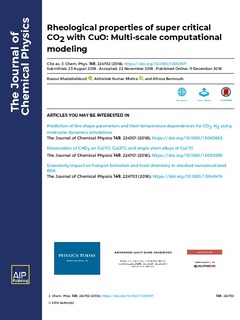| dc.contributor.author | Khaledialidusti, Rasoul | |
| dc.contributor.author | Mishra, Abhishek Kumar | |
| dc.contributor.author | Barnoush, Afrooz | |
| dc.date.accessioned | 2019-04-26T07:40:08Z | |
| dc.date.available | 2019-04-26T07:40:08Z | |
| dc.date.created | 2019-01-31T09:46:11Z | |
| dc.date.issued | 2018 | |
| dc.identifier.issn | 0021-9606 | |
| dc.identifier.uri | http://hdl.handle.net/11250/2595600 | |
| dc.description.abstract | A multi-scale computational methodology based on the density functional theory and molecular dynamics has been used to investigate the rheological properties of super critical CO2 with CuO nano-particle (NP). Density functional theory which treats the electron density as the central variable has been used to explore the adsorption of CO2 molecules on the two most stable CuO surfaces [i.e., (111) and (011)] at absolute zero. The results of this theory would provide valuable information to make CuO NPs with the surface where the CO2 adsorption is maximum in order to have a stronger mono-layer of adsorbed CO2 molecules on the surface of the NP which is the most crucial factor in formation of a stable nanofluid. The results show that the CO2 molecule is adsorbed more strongly on the (011) surface with an adsorption energy of −99.06 kJ/mol compared to the (111) surface. A computational methodology based on molecular dynamics has been used to evaluate the enhancement of the rheological properties of the super-critical CO2 liquid based nanofluid at different temperatures and pressures. In this scale, first, the CO2 liquid has been modeled by employing the condensed-phase optimized molecular potentials for atomistic simulation studies (COMPASS) force field potential and the fluid properties computed are in excellent agreement with the literature and experiment values. Second, the nanofluid has been modeled in order to study the enhancement of the fluid properties with the CuO NPs. The charged optimized many-body force field potential has been employed to consider the effect of the charge transferring between the NPs and liquid molecules and breaking of existing bonds and the formation of new bonds. The COMPASS force field potential is also employed for the interactions between CO2 molecules. The combination of these potentials is quite a new approach for the study of the super-critical (SC)-CO2 based nanofluid. The results show that the viscosity of the SC-CO2 is enhanced between 1.3 and 2.5 times under the temperature and pressure conditions studied. | nb_NO |
| dc.language.iso | eng | nb_NO |
| dc.publisher | AIP Publishing | nb_NO |
| dc.title | Rheological properties of super critical CO2 with CuO: Multi-scale computational modeling | nb_NO |
| dc.type | Journal article | nb_NO |
| dc.type | Peer reviewed | nb_NO |
| dc.description.version | publishedVersion | nb_NO |
| dc.source.volume | 149 | nb_NO |
| dc.source.journal | Journal of Chemical Physics | nb_NO |
| dc.source.issue | 22 | nb_NO |
| dc.identifier.doi | https://doi.org/10.1063/1.5053571 | |
| dc.identifier.cristin | 1669774 | |
| dc.description.localcode | © 2018 Author(s). Locked until 11.12.2019 due to copyright restrictions. | nb_NO |
| cristin.unitcode | 194,64,92,0 | |
| cristin.unitname | Institutt for maskinteknikk og produksjon | |
| cristin.ispublished | true | |
| cristin.fulltext | postprint | |
| cristin.qualitycode | 1 | |
